Related Research Articles

Michelangelo di Lodovico Buonarroti Simoni, known mononymously as Michelangelo, was an Italian sculptor, painter, architect, and poet of the High Renaissance. Born in the Republic of Florence, his work was inspired by models from classical antiquity and had a lasting influence on Western art. Michelangelo's creative abilities and mastery in a range of artistic arenas define him as an archetypal Renaissance man, along with his rival and elder contemporary, Leonardo da Vinci. Given the sheer volume of surviving correspondence, sketches, and reminiscences, Michelangelo is one of the best-documented artists of the 16th century. He was lauded by contemporary biographers as the most accomplished artist of his era.

Raffaello Sanzio da Urbino, now generally known in English as Raphael, was an Italian painter and architect of the High Renaissance. His work is admired for its clarity of form, ease of composition, and visual achievement of the Neoplatonic ideal of human grandeur. Together with Leonardo da Vinci and Michelangelo, he forms the traditional trinity of great masters of that period.
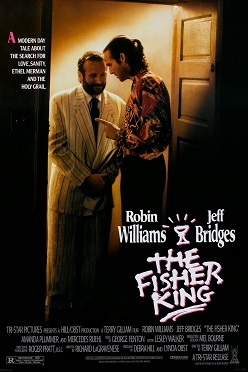
The Fisher King is a 1991 American fantasy comedy-drama film written by Richard LaGravenese and directed by Terry Gilliam. Starring Robin Williams and Jeff Bridges, with Mercedes Ruehl, Amanda Plummer and Michael Jeter in supporting roles, the film tells the story of a radio shock jock who tries to find redemption by helping a man whose life he inadvertently shattered. It explores "the intermingling of New York City's usually strictly separated social strata", and has been described as "a modern-day Grail Quest that fused New York romantic comedy with timeless fantasy".

Forest Lawn Memorial Park is a privately owned cemetery in Glendale, California, United States. It is the original and current flagship location of Forest Lawn Memorial-Parks & Mortuaries, a chain of six cemeteries and four additional mortuaries in Southern California.

Sir Harold Mario Mitchell Acton was a British writer, scholar, and aesthete who was a prominent member of the Bright Young Things. He wrote fiction, biography, history and autobiography. During his stay in China, he studied the Chinese language, traditional drama, and poetry, some of which he translated.
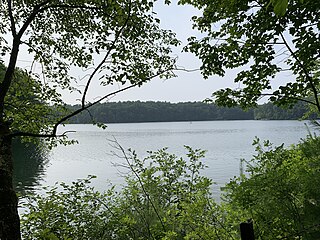
Walden Pond is a celebrated pond in Concord, Massachusetts, in the United States. A good example of a kettle hole, it was formed by retreating glaciers 10,000–12,000 years ago. The pond is protected as part of Walden Pond State Reservation, a 335-acre (136 ha) state park and recreation site managed by the Massachusetts Department of Conservation and Recreation. The reservation was designated a National Historic Landmark in 1962 for its association with the writer Henry David Thoreau (1817–1862), whose two years living in a cabin on its shore provided the foundation for his famous 1854 work, Walden; or, Life in the Woods. The National Historic Preservation Act of 1966 ensured federal support for the preservation of the pond.

The Thinker is a bronze sculpture by Auguste Rodin, situated atop a stone pedestal. The work depicts a nude male figure of heroic size sitting on a rock. He is seen leaning over, his right elbow placed on his left thigh, holding the weight of his chin on the back of his right hand. The pose is one of deep thought and contemplation, and the statue is often used as an image to represent philosophy.
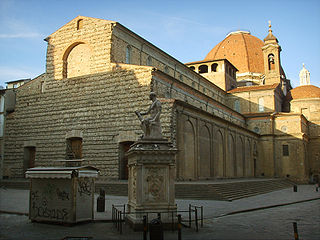
The Basilica di San Lorenzo is one of the largest churches of Florence, Italy, situated at the centre of the main market district of the city, and it is the burial place of all the principal members of the Medici family from Cosimo il Vecchio to Cosimo III. It is one of several churches that claim to be the oldest in Florence, having been consecrated in 393 AD, at which time it stood outside the city walls. For three hundred years it was the city's cathedral, before the official seat of the bishop was transferred to Santa Reparata.
The Agony and the Ecstasy (1961) is a biographical novel of Michelangelo Buonarroti written by American author Irving Stone. Stone lived in Italy for years visiting many of the locations in Rome and Florence, worked in marble quarries, and apprenticed himself to a marble sculptor. A primary source for the novel is Michelangelo's correspondence, all 495 letters of which Stone had translated from Italian by Charles Speroni and published in 1962 as I, Michelangelo, Sculptor. Stone also collaborated with Canadian sculptor Stanley Lewis, who researched Michelangelo's carving technique and tools. The Italian government lauded Stone with several honorary awards for his cultural achievements highlighting Italian history.
La Pietra: Hawaii School for Girls, also referred to as La Pietra or Hawaii School for Girls, is a private school for girls in grades 6–12 located in Honolulu, Hawaii. Founded in 1964 by Lorraine Cooke, it moved to the current La Pietra campus in 1969. Barbara Cox Anthony chaired the school's board of trustees until her death in 2007. The school is at the foot of Diamond Head. The main building was designed by Chicago architect, David Adler and was modeled after an Italian villa in Florence, Italy of the same name.

The Harlan County War, or Bloody Harlan, was a series of coal industry skirmishes, executions, bombings and strikes that took place in Harlan County, Kentucky, during the 1930s. The incidents involved coal miners and union organizers on one side and coal firms and law enforcement officials on the other. The Harlan County coal miners campaigned and fought to organize their workplaces and better their wages and working conditions. It was a nearly decade-long conflict, lasting from 1931 to 1939. Before its conclusion, an unknown number of miners, deputies and bosses would be killed, state and federal troops would occupy the county more than half a dozen times, two acclaimed folk singers would emerge, union membership would oscillate wildly and workers in the nation's most anti-labor coal county would ultimately be represented by a union.

The Battle of Blair Mountain was the largest labor uprising in United States history and is the largest armed uprising since the American Civil War. The conflict occurred in Logan County, West Virginia, as part of the Coal Wars, a series of early-20th-century labor disputes in Appalachia.

Vincenzo Danti was an Italian Renaissance sculptor from Perugia.

The Marzocco is the heraldic lion that is a symbol of Florence, and was apparently the first piece of public secular sculpture commissioned by the Republic of Florence, in the late 14th century. The lion stood at the heart of the city in the Piazza della Signoria at the end of the platform attached to the Palazzo Vecchio called the ringhiera, from which speakers traditionally harangued the crowd. This is now lost, having weathered with time to an unrecognizable mass of stone.
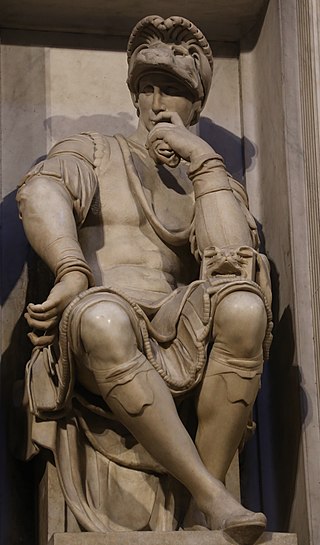
Michelangelo had a complicated relationship with the Medici family, who were for most of his lifetime the effective rulers of his home city of Florence. The Medici rose to prominence as Florence's preeminent bankers. They amassed a sizable fortune some of which was used for patronage of the arts. Michelangelo's first contact with the Medici family began early as a talented teenage apprentice of the Florentine painter Domenico Ghirlandaio. Following his initial work for Lorenzo de' Medici, Michelangelo's interactions with the family continued for decades including the Medici papacies of Pope Leo X and Pope Clement VII.
Perugia Press is an American not-for-profit poetry press located in Florence, Massachusetts and founded in 1997 by Editor and Director Susan Kan. The press publishes one collection of poetry each year, by a woman poet chosen from its annual book contest, the Perugia Press Prize.
Diane Gilliam Fisher is an American poet. She is author of several poetry collections, most recently, Kettle Bottom.

Tommaso dei Cavalieri was an Italian nobleman, who was the object of the greatest expression of Michelangelo's love. Michelangelo was 57 years old when he met Cavalieri in 1532. The young noble was exceptionally handsome, and his appearance seems to have fit the artist's notions of ideal masculine beauty, for Michelangelo described him as "light of our century, paragon of all the world". The two men remained close to each other throughout their lives and Cavalieri was present at the artist's death.
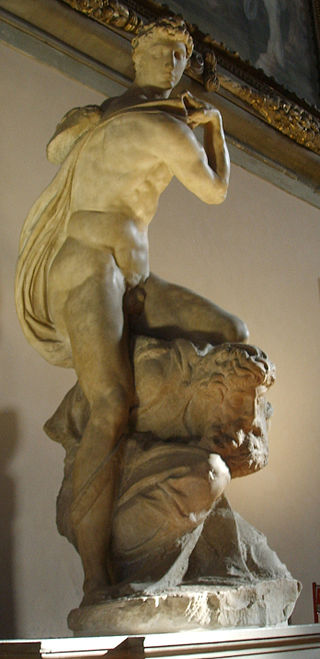
The Genius of Victory is a 1532–1534 marble sculpture by Michelangelo, produced as part of a design for the tomb of Pope Julius II. It is 2.61 m high and is now in the Salone dei Cinquecento of the Palazzo Vecchio in Florence.

Pietra serena is a blue-gray sandstone used extensively in Renaissance Florence for architectural details. It is also known as Macigno stone. The material obtained at Fiesole is considered the best and is also quarried at Arezzo, Cortona, and Volterra, although it is no longer being actively mined and has been placed under conservation status due to depleting resources.
References
- ↑ Fisher, Diane. Kettle Bottom. Florence, Massachusetts: Perugia Press, 2004.
- ↑ "Kettle Bottom: Diane Gilliam Fisher". Archived from the original on 2009-11-18. Retrieved 2010-02-09.
- ↑ Fisher, Diane. Kettle Bottom. Florence, Massachusetts: Perugia Press, 2004, p. 1
- ↑ Fisher, Diane. Kettle Bottom. Florence, Massachusetts: Perugia Press, 2004, p. 7
- ↑ "Erin Murphy: "Past 'Dark Come Earlier Every Day': Diane Gilliam Fisher's 'Kettle Bottom'"".
- ↑ Fisher, Diane. Kettle Bottom. Florence, Massachusetts: Perugia Press, 2004, p. 82-83
- ↑ "Mount Wachusett Community College News & Events: What's up at the Mount". Archived from the original on 2008-12-03. Retrieved 2008-09-29.